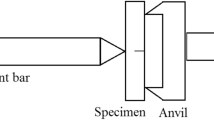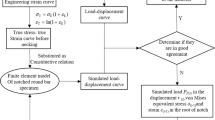Abstract
To thoroughly understand the dynamic behavior of a fracture specimen under stress wave loading, dynamic fracture test with various three-point bend (3PB) specimens are performed on the Hopkinson bar loaded experimental apparatus. The contact state between the fracture specimen and supports during the loading process is examined via stress wave propagation analysis. The experimental results show that the fracture specimen with usual dimensions does not keep contact with supports in the initial loading stage, i.e. a loss of contact phenomenon occurred. The specimen dimensions and the span of the loading apparatus are important factors affecting specimen’s contact state. The loss of contact is more obvious with increasing span under the same specimen dimensions. Conversely, the loss of contact gradually disappears with increasing specimen length or increasing width under a fixed span. Based on experimental investigations, a criterion is established to ensure the fracture specimen keep in contact with supports during dynamic fracture test.
Similar content being viewed by others
References
Bacon C, Farm J, Lataillade JL (1994) Dynamic fracture toughness determined from load-point displacement. Exp Mech 34: 217–221
Böhme W, Kalthoff JF (1982) The behavior of notched bend specimens in impact testing. Int J Fract 20: R139–4
Böhme W (1990) Dynamic key-curves for brittle fracture impact tests and establishment of a transition time. In: Gudas JP et al (eds) Fracture mechanics: twenty-first symposium. ASTM STP1074, pp 144–155
Crouch BA (1993) Finite element modeling of the three-point bend impact test. Comput Struct 48: 167–172
Irfan MA, Prakash V (2000) Dynamic deformation and fracture behavior of novel damage tolerant discontinuously reinforced aluminum composites. Int J Solids Struct 37: 4477–4507
Jiang FCh, Rohatgi AA, Vecchio KS, Cheney JL (2004) Analysis of the dynamic response for a pre-cracked three-point bend specimen. Int J Fract 127: 147–164
Jiang FCh, Vecchio SK (2007) Experimental investigation of dynamic effects in a two-bar/three-point bend fracture test. Rev Scienti Instrum 78: 063903
Jiang FCh, Vecchio SK (2007) Dynamic effects in Hopkinson bar four-point bend fracture. Metallurgical Mater Trans 38: 2896–2905
Jiang FCh, Vecchio SK (2009) Hopkinson bar loaded fracture experimental technique: a critical review of dynamic fracture toughness test. Appl Mech Rev 7: 1–39
Johnstone C, Ruiz C (1995) Dynamic testing of ceramics under tensile stress. Int J Solids Struct 32: 2647–2656
Kalthoff JF (1985) On the measurement of dynamic fracture toughness—a review of recent work. Int J Fract 27: 277–295
Marur PR (1996) On the effects of higher vibration modes in the analysis of three point bend testing. Int J Fract 77: 367–379
Marur PR (1998) Charpy specimen-a simply supported beam or a constrained free-free beam. Eng Fract Mech 61: 369–385
Meyers AM (1994) Dynamic behavior of materials. A Wiley-Interscience Publication, New York, pp 488–522
Nishioka T, Perl M, Atluri SN (1983) An analysis of dynamic fracture in an impact test specimen. J Press Vessel Technol 105: 124–130
Orynyak IV, Krasowsky AJA (1998) The modeling of elastic response of a three-point bend specimen under impact loading. Eng Fract Mech 60: 563–574
Peuser T (1983) Dynamic analysis of impact test specimens. International conference on application of fracture mechanics to materials and structure, pp 455–464
Popelar CH, Walker JD, Anderson CE, Johnson GR Jr, Beissel SR (1999) Penetrator case fracture predictive technology: volume I-dynamic fracture mechanics methodology. AFRL-MN-EG-TR-1999-7054, Air Force Research Laboratory
Popelar CH, Anderson CE Jr, Nagy A (2000) An experimental method for determining dynamic fracture toughness. Exp Mech 40: 401–406
Rader D, Mao M (1972) Amplification of longitudinal stress pulse in elastic bars with an intermediate tapered region. Exp Mech 2: 90–94
Raman PS, Venkitanarayanan P (2003) An experimental investigation of dynamic crack propagation in a brittle material reinforced with a ductile layer. Opt Lasers Eng 40: 289–306
Rittel D, Pineal A, Clisson J, Rota L (2002) On testing of charpy specimens using the one-point bend impact technique. Exp Mech 42: 247–251
Rizal S, Homma H, Nazer M, Kishida E (2002) Experimental approach to dimple fracture mechanisms under short pulse loading. Eng Fract Mech 69: 1377–1389
Ruiz C, Mines RAW (1985) The Hopkinson pressure bar: an alternative to the instrumented pendulum for Charpy tests. Int J Fract 29: 101–107
Rubio L, Fernández-Sáez J, Navarro C (2003) Determination of dynamic fracture-initiation toughness using three-point bending tests in a modified Hopkinson pressure bar. Exp Mech 43: 379–385
Yokoyama T (1993) Determination of dynamic fracture-initiation toughness using a novel impact bend test procedure. J Press Vessel Technol 115: 389–397
Author information
Authors and Affiliations
Corresponding author
Rights and permissions
About this article
Cite this article
Guo, C., Jiang, F., Liu, R. et al. Size effect on the contact state between fracture specimen and supports in Hopkinson bar loaded fracture test. Int J Fract 169, 77–84 (2011). https://doi.org/10.1007/s10704-011-9588-8
Received:
Accepted:
Published:
Issue Date:
DOI: https://doi.org/10.1007/s10704-011-9588-8




